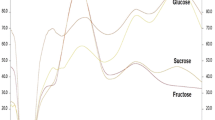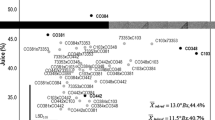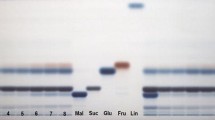Abstract
Taro [Colocasia esculenta (L.) Schott] is cultivated for its starchy corm consumed baked or boiled and processed in snacks (chips or French fries) to satisfy growing urban markets. Most consumers prefer non sweet taros. High content of sucrose (non-reducing sugar), glucose and fructose (reducing sugars) represent undesirable characteristics because they cause browning of the snacks. Breeding taro for improved corm quality is complex and phenotypic recurrent selection is impaired by the long growth cycle and the low vegetative propagation ratio. New high-throughput phenotyping tools are needed to select suitable hybrids in early clonal generations. The aim of the present study was to develop an HPTLC protocol for the quantitation of sugars in the fresh corm (FW). The individual sugars values in 60 hybrids released by four different breeding programs were compared with 300 cultivars from six different countries. Sucrose, glucose, fructose, maltose and ribose were quantitated. Mean total sugars varied from 1.83 to 6.28%FW in hybrids and from 1.32 to 7.69%FW in cultivars. The ratio sucrose/reducing sugars varied from 0.06 to 4.34 in hybrids and from 0.04 to 4.82 in cultivars. The protocol developed in this study is rapid, cost efficient, environment-friendly and more accurate than previous techniques based on dry matter because sample preparation is known to affect chemical composition of individual sugars. This technique can be used in taro breeding programmes for the early detection of undesirable hybrids with high levels of reducing sugars.



Similar content being viewed by others
References
Alcantara RM, Hurtada WA, Dizon EI (2013) The nutritional value and phytochemical components of Taro [Colocasia esculenta (L.) Schott] powder and its selected processed foods. J Nutr Food Sci 3:207. doi:10.4172/2155-9600.1000207
AOAC (2002) Guidelines for single laboratory validation of chemical methods for dietary supplements and botanicals. http://www.aoac.org/imis15_prod/AOAC_Docs/StandardsDevelopment/SLV_Guidelines_Dietary_Supplementspdf. Accessed 29 March 2016
Aranda MB, Vega MH, Villages RF (2005) Routine method for quantification of starch by planar chromatography (HPTLC). J Plan Chrom 16:285–289
Bernardi T, Pedrini P, Marchetti MG, Tamburini E (2015) Separation and quantitative determination of carbohydrates in microbial submerged cultures using different planar chromatography techniques (HPTLC, AMD, OPLC). J Anal Bioanal Technol 6:247. doi:10.4172/2155-98721000250
Bradbury JH, Holloway WD (1988) Chemistry of tropical root crops: significance for nutrition and agriculture in the Pacific. ACIAR, Canberra, p 201
Champagne A, Legendre L, Lebot V (2009) Chemotype profiling to guide breeders and explore traditional selection of root crops in Vanuatu, South Pacific. J Agric Food Chem 57:10363–10370
Champagne A, Legendre L, Lebot V (2013) Biofortification of taro (Colocasia esculenta) through breeding for increased contents in carotenoids and anthocyanins. Euphytica 194(1):125–136
FAOSTAT (2017) http://www.fao.org/faostat/en/#home. Accessed April 2017
Fullagar R, Field J, Denham T, Lentfer C (2006) Early and mid Holocene tool-use and processing of taro (Colocasia esculenta), yam (Dioscorea sp.) and other plants at Kuk Swamp in the highlands of Papua New Guinea. J Arch Sci 33(1):595–614
Guchhait A, Battacharya A, Pal S, Mazumbar D, Chattopadahyay A, Das AK (2008) Quality evaluation of cormels of new germplasm of taro. Int Jour Veg Sci 14(4):304–321
Harding RM, Revil PA, Hafner GJ, Yang I, Maino MK, Devitt LC, Dowling ML, Dale JL (2004) Characterisation of taro viruses and the development of diagnostic tests. In: Guarino L, Taylor M, Osborn T (eds) Proceedings of the 3rd taro symposium held in Nadi, Fiji. Secretariat of the Pacific Community, Suva, pp 98–101
Huang CCC, Chen WC, Wang CCR (2007) Comparison of Taiwan paddy- and upland-cultivated taro (Colocasia esculenta (L.)) cultivars for nutritive values. Food Chem 102:156–250
Iosefa T, Taylor M, Hunter D, Tuia V (2012) The taro improvement programme in Samoa: sharing genetic resources through networking. FAO RAP-NIAS: plant genetic resources in Asia and the Pacific: impacts and future. In: Proceedings of a symposium held in Tsukuba, Japan, pp 25–40
Kaushal P, Kumar V, Sharma HK (2013) Utilization of taro (Colocasia esculenta): a review. J Food Sci Technol 52(1):27–40
Kreike CM, van Eck HJ, Lebot V (2004) Genetic diversity of taro, Colocasia esculenta (L.) Schott, in Southeast Asia and the Pacific. Theor Appl Gen 109:761–768
Kristl J, Ivancic A, Mergedus A, Sem V, Kolar M, Lebot V (2016) The variation of nitrates within taro (Colocasia esculenta) corms. J Food Comp Anal 47:76–81
Lebot V, Gunua T, Pardales JR, Prana MD, Thongjiem MS, Viet NV, Yap TC (2004) Characterisation of taro (Colocasia esculenta (L.) Schott) genetic resources in Southeast Asia and Oceania. Gen Res Crop Evol 51:381–392
Lebot V, Malapa R, Bourrieau M (2011) Rapid estimation of taro quality by near infrared spectroscopy. J Food Agric Chem 59(17):9327–9334
Mare RM, Modi AT (2012) Taro corm quality in response to planting date and post-harvest storage: 1-starch content and reducing sugars. Afric J Agric Res 7(19):3014–3021
Martens S, Mithöfer A (2005) Flavones and flavone synthases. Phytochemistry 66:2399–2407
Matthews PJ, Lockhart PJ, Ahmed I (2017) Phylogeography, ethnobotany and linguistics issues arising from research on the natural and cultural history of taro, Colocasia esculenta (L.) Schott. Man India 97(1):353–380
Mbofung CMF, Njintang AYN, Bouba B, Balaam F (2006) Physicochemical and functional properties of six varieties of taro (Colocasia esculenta L. Schott) Flour. J Food Technol 4(2):135–142
Mergedus A, Kristl J, Ivancic A, Sober A, Sustar V, Krizan T, Lebot V (2015) Variation of mineral composition in different parts of taro (Colocasia esculenta) corms. Food Chem 170:37–46
Midmore M, White D, Nguyen V, Hicks D, Coleman E, Newman S, Wilk P, Reeve D, McLauglhin P (2006) Development of taro, yam, yam bean, and sweet potato exports to Japan and the USA: a report for the Rural Industries Research and Development Corporation. RIRDC Publication, Kingston, p 26
Morlock GE, Gulnar S (2012) Comparison of two orthogonal liquid chromatographic methods for quantification of sugars in food. J Liquid Chrom Relat Technol 34(10–11):902–919
Muñoz-Cuervo I, Malapa R, Michalet S, Lebot V, Legendre L (2016) Secondary metabolite diversity in taro (Colocasia esculenta Schott) corms. J Food Comp Anal 52:24–32
Omane E, Oduro KA, Cornelius EW, Opoku I, Akrofi A, Sharma K, Bandyopadhyay R (2012) First report of leaf blight of taro (Colocasia esculenta) caused by Phytophthora colocasiae in Ghana. Plant Dis 96(2):292
Pereira PR, Silva JT, Verícimo MA, Paschoalin VMF, Teixeira GAPB (2015) Crude extract from taro (Colocasia esculenta) as a natural source of bioactive proteins able to stimulate haematopoietic cells in two murine models. J Func Foods 18:333–343
Simsek S, El SN (2015) In vitro starch digestibility, estimated glycemic index and antioxidant potential of taro (Colocasia esculenta L. Schott) corm. Food Chem 168(5):257–261
Soulard L, Letourmy P, Cao TV, Lawac F, Chaïr H, Lebot V (2016) Evaluation of vegetative growth, yield and quality related traits in taro (Colocasia esculenta [L.] Schott). Crop Sci 56:976–989
Suja G, Byju G, Jyothi AN, Veena SS, Sreekumar J (2017) Yield, quality and soil health under organic vs conventional farming in taro. Sci Hortic 218:334–343
Tamate J, Bradburry H (1985) Determination of sugars in tropical root crops using 13C N.m.r spectroscopy: comparison with the HPLC method. J Sci Food Agric 36:1291–1302
Wills RBH, Lim JSK, Greenfield H, Bayliss-Smith T (1983) Nutrient composition of taro (Colocasia esculenta) cultivars from the Papua New Guinea Highlands. J Sci Food Agric 34:1137–1142
World Health Organization (WHO) (2015) Guideline: sugars intake for adults and children. World Health Organization (WHO), Geneva
Acknowledgements
This research was financially supported by the Europe-Aid project “Adapting clonally propagated crops to climatic and commercial changes” (Grant No. DCI-FOOD/2010/230-267 SPC). Special thanks are due to Prof. Janja Kristl, University of Maribor, Slovenia, for preliminary TLC tests to identify ribose.
Author information
Authors and Affiliations
Corresponding author
Ethics declarations
Conflict of interest
The authors declare that there is no conflict of interest.
Rights and permissions
About this article
Cite this article
Lebot, V., Lawac, F. Quantitative comparison of individual sugars in cultivars and hybrids of taro [Colocasia esculenta (L.) Schott]: implications for breeding programs. Euphytica 213, 147 (2017). https://doi.org/10.1007/s10681-017-1946-9
Received:
Accepted:
Published:
DOI: https://doi.org/10.1007/s10681-017-1946-9




